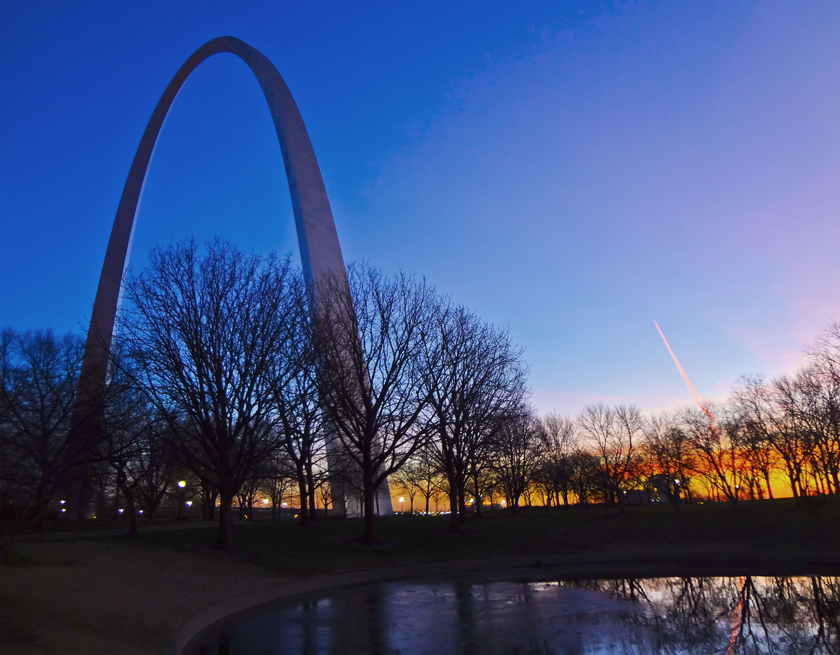Prosecutors Reveal New Details of Theft Claim in St. Louis Art Museum Ka Nefer Nefer Mask Forfeiture
 |
| St. Louis Gateway Arch Source: Sue Ford, National Park Service |
Prosecutors in the case of United States v. Mask of Ka-Nefer-Nefer today filed a Reply in Support of Its Motion to Reconsider. The U.S. Attorney for the Eastern District of Missouri hopes to reverse a judge’s April dismissal of the case. The government ultimately seeks to forfeit the allegedly stolen Ka Nefer Nefer mummy mask located at the St. Louis Art Museum (SLAM) and return it to Egypt. SLAM denies that the mask is stolen and asserts ownership over the artifact.
The museum filed an objection earlier this week to the government’s motion requesting the judge to reconsider the dismissal of the case. Today’s pleading by the government responds to the museum’s objection.
The government says that it should be permitted to amend its original complaint if the court continues to uphold its dismissal order. The prosecution goes on to reveal more specific allegations that it would articulate in a revised complaint:
“To the extent … that a fuller explanation of the new allegations to be incorporated into an amended complaint would aid the Court in assessing the United States’ request for time to seek leave to amend, the United States is glad to elaborate. If deemed necessary by the Court, the United States’ proposed amended complaint would:
• expressly allege that the Mask was stolen from box number fifty-four at Saqqara between 1966 and 1973;
• recite the provisions of the controlling Egyptian cultural patrimony law, Law No. 215, which provides that ancient artifacts excavated after 1951 are the national property of the Republic of Egypt, and establish the absence of any facts that would authorize the Museum’s ownership of the Mask under Egyptian law;
• summarize the relevant Egyptian export laws, which required application to be made to the Egyptian government before the Mask could be exported from Egypt, and allege the absence of any record of lawful exportation;
• detail the sale agreement between the Art Museum and the sellers for the purchase of the Mask, including the obligation of the sellers to provide copies of applicable export and import licenses, and allege the breach of those obligations;
• advance allegations regarding the sellers’ knowledge of the falsity of the Mask’s supposed provenance, as well as information regarding the criminal history of the sellers, to suggest the illicit nature of the sale;
• describe the Museum’s merely pro forma “investigation” into the Mask’s provenance to support the inference that it knew or was willfully blind to the fact that the Mask was stolen property both before and after its importation; and
• offer citations to numerous other provisions of law, including but not limited to Egyptian [patrimony] law No. 215 and 18 U.S.C. §§ 2314 and 2315 [the National Stolen Property Act], to bolster the conclusion that the Mask was imported into the United States ‘contrary to law.'”
Federal attorneys further argue that “that the Museum apparently now concedes, for the first time on this Motion, that probable cause, not a preponderance of the evidence, is the ultimate trial burden that the United States will have to bear. The Museum also appears to agree that the United States should not have to allege ‘the date, location, or motive behind the stealing, let alone the identity of the thief’ in order to meet that burden, so long as it can establish that the Mask is ‘stolen.’ The Museum likewise appears to admit that an artifact is considered ‘stolen’ if its private ownership violates originating country’s patrimony laws.”
Prosecutors add that SLAM does not correctly construe the law or the facts of the case. The U.S. Attorney’s Office writes
“The Museum takes a detour, however, when it attempts to distinguish United States v. One Lucite Ball Containing Lunar Material on the ground that ‘until 1983, there was no Egyptian law that unequivocally established Egyptian ownership of items like the Mask.’ That claim is not only outside the face of the complaint; it is also incorrect. As the United States set out in its Motion to Strike the Museum’s claim for lack of standing, Egyptian law has provided for national ownership of cultural artifacts like the Mask since at least 1951. While it will ultimately be for the Court to determine whose interpretation of Egyptian law is correct, any such determination is a matter of law that did not need to be pled, and in fact was not pled, on the face of the complaint. Thus, any such contention of the Museum’s is beyond this Court’s consideration on this motion.”
[Blogger’s sidebar: United States of America v. One Lucite Ball containing Lunar Material (one Moon Rock) and One Ten Inch by Fourteen Inch Wooden Plaque is a federal district court case where authorities successfully seized a moon rock originally given by President Richard Nixon to Honduras. The rock was bought for $50,000 by claimant Alan Rosen, who purchased the moon rock from a retired Honduran military officer. The moon rock went missing from the Honduran presidential palace during the 1990’s. The case resulted in the forfeiture of the lunar rock to the federal government in 2003 after government lawyers argued that the rock was stolen from Honduras and smuggled into the United States in violation of 19 U.S.C. 1595a(c)(1)(A), the same statute invoked in the Ka-Nefer-Nefer case.]
CONTACT: www.culturalheritagelawyer.com

